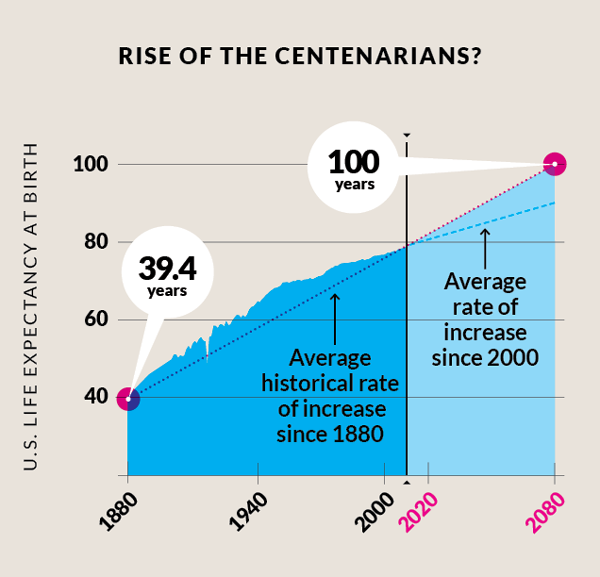
What experiences will mark the phases of her life?
Life Across Time
Gail Sheehy published several books in the 1990s describing passages adults experience throughout their lives. She talked about youth taking longer to grow up and elders longer to die, and that during mid-life people embrace a second adulthood with deeper, more playful, and creative meaning. The problem with Sheehy’s concept today, is that it does not embrace the majority of Americans. Though longevity continues to increase in all segments of society, vast socio-economic differences set people along different paths to old age. Not everyone can afford to have a mid-life crisis. People living in subsets of society go through passages that vary greatly. Forty percent of Americans living in poverty don’t have a chance to customize their experiences as Sheehy suggested.
One hundred-sixty-years ago, life expectancy in the U.S. was 39.41 years. In 2020 it was 78.8. Despite the pandemic, 39.39 years is still quite an increase. Americans shouldn’t be complacent though, for expectancy has been on a slight slide downward since 2015. Negative societal trends such as unbalanced diets, sedentary lifestyles, high medical costs, and increasing rates of suicide and drug use are impacting the poor more than the wealthy.
Despite the drop, centenarians have become more common. The United Nations estimates this year that 573,000 people will live to be 100, with that number escalating to 757,000 by 2045. The U.S. has the highest number of centenarians in the world with 97,000 alive in the country today. Kane Tanaka from Japan at 117 years is currently the oldest known person alive today. Back in 2003, when sixty gerontologists were asked to estimate life expectancy in 2100, their combined guesstimates had a median expectation of 100 and a mean of 292 years. The UN currently projects that elders over 60 will double by 2050. With such an increase I can’t help but wonder what will happen when more people live to 100? How will they pass their time and be supported through 30 or more years of retirement? What differences will there be between different segments of society?

Life’s passages don’t proceed in straight predictable ways as was once thought. The idea of retiring after 40 years with one company and taking home a pension and gold watch is gone. No longer do workers believe employers will be loyal to them. According to the Bureau of Labor Statistics in 2019, people change jobs an average of 12 times and spend five years or less in each position. Job changes that require a move, disrupt relationships. The U.S.Census shows that the average American moves 11.7 times in a lifetime. In addition to employment concerns, people move because of changes in marital status, climate conditions, retirement, neighborhood changes, health issues, layoffs, and pursuing dreams.
A high school graduate’s road to the grave will consist of many twists and turns. Independent living, long considered a milestone in the transition to adulthood, is not an option for 48 percent of young adults. The Pew Research Center reports that in 2020, 52 percent of young adults still lived with their parents, the highest amount since the Great Depression. Twenty-year-olds form goals that are expansive, focused on gaining knowledge and information for a long and nebulous future.
When finally independent, they move to a stage traditionally marked by blending lives. That previously meant marriage to a person of the opposite sex followed by the birth or adoption of a child by the time the woman reached 21. Today, the average age women give birth is 26 or 31 years for mothers with higher education. More women become single mothers than they did twenty years ago, but, whether single or coupled, they opt for fewer babies. Due to financial concerns, global warming, and political unrest many twenty and thirty-year-olds choose not to bring children into the world at all.

Fewer couples married today will remain with their original partner. Instead, they will have serial liaisons throughout their long lives. Cohabitation, no longer confined to relationships between men and women, commonly takes place without marriage vows. Fifty percent of those who do marry will divorce or separate. Though divorce and marriage rates have been declining over the 10 years, the COVID-19 pandemic may reverse the trend. According to BBC, the increase in domestic violence and relationships stressed by the lockdown, financial strain, and political discord may usher in the largest single-year increase in divorce in decades.
Parents with children are challenged to balance work with personal life. Remaining happy and healthy is not always easy when there are multiple demands on time and money. Growing families add pressure for more space and a greater income. Though some parents can provide support and childcare for their children, many can’t. According to a 2019, 60 Minutes newscast, 40% of U.S. families struggle to survive. The pandemic hit women especially hard. More than 2.3 million women have left the workforce since February 2020. A majority of American families require income from two working adults.
Moving and changing neighborhoods disrupts established social patterns and schooling for children. Stress increases as old relationships end and health can suffer. I was once told that it takes twenty years to make a friend. There is some truth in what was said, for it does take a long time to get to know people well enough to be able to trust and depend on them.
When a youth moves out of a childhood home, parents enjoy feelings of freedom not felt for years. Life appears sunny to most empty-nesters. They still have their health and time to travel and take up hobbies. However, for many parents, an empty house brings on a crisis of purpose. Careers may come into question, making them want to try something new. Bored with jobs and perhaps their partner, mid-lifers crave new experiences. They want to feel as free as they did when in their twenties. Unfortunately, middle-age is when they begin caring for their elderly parents.
But, now in their fifties, there is also the worry of losing their jobs. Many workers are passionate about what they do and want to stay employed into their senior years. Those laid off can struggle to find well-paid employment. Many are forced to take a cut in salary or even a low-paying job. Walmart, the largest employer in the United States, pays between $25,000 and $30,000 a year for a full-time employee. Amazon warehouse workers make $31,200 annually. Universities and colleges have the best reputation for keeping older people employed at a fair wage.
According to a recent Gallup survey, the average age for retirement at 61 is not by choice. Most people prefer to stay in the workforce until they are 65-67. Nine million people over 65 find it necessary to stay employed. The book and movie, Nomadland do a good job showing how Americans over 60, faced with debt and high housing prices, pack everything up to live in their vans and RVs, work odd jobs, and find adventure on the road.
The crisis of aging can be painful to go through, though it does bring excitement as well. Seniors faced with an ever-increasing number of years to dream anew think about how to continue living meaningfully. For some grandparents that means raising their grandchildren. Nationwide, 2.7 million are doing so, with one-fifth having incomes below the poverty line. Children who reside with their grandparents are more likely to have experienced traumatic events that will influence their development.
Retirees with the means to do so engage in educational pursuits and travel. Snowbirds move south in the winter and north during summer. Before the pandemic, 28 percent of elders pushed worry aside and stepped forward to volunteer. They benefited by staying healthier than non-engaged retirees, reporting fewer cognitive complaints, depressive symptoms, and functional limitation. Volunteers have a lower prevalence of dementia and live longer. Elders are happiest when able to fulfill emotionally meaningful goals.
Studies show that seniors are generally satisfied in old age and that most report relatively high levels of emotional well-being. This is especially true when life is controllable and social supports are strong.
But, there comes a time when aging brings confinement, causing problems for offspring and family members. As more people reach 100, this will add pressure to health and social systems. With fewer adult children having adequate resources to help aging parents, the government will need to step in. Elders without family, who imagined friends would be there for them when needed, may get a painful surprise when their support system moves into retirement homes or leaves the neighborhood to be closer to their children.
But those fortunate enough to have been raised in a secure loving environment can take heart. They do better with caregivers than those who didn’t have close parental relationships when young. They tend to feel less vulnerable and less subject to emotional distress. Most seniors look back on their lives with contentment, considering what went well and what they wish had been different, accepting what was. Aging well has to do with the ability to acknowledge that you did the best you could throughout life.
_______________
I know this is a long blog and hope you will not be frustrated by its length. There is a lot to cover when considering life’s passages. Your comments are most welcome .
References
O’Neil, a. (2021) Life expectancy (from birth) in the United States, from 1860 to 2020. Statosta. retrieved from https://www.statista.com/statistics/1040079/life-expectancy-united-states-all-time/
Buchholz,K. (2021) Is 100 the New 80?: Centenarians are Becoming More Common. World Economic Forum. retrieved from https://www.weforum.org/agenda/2020/07/is-100-the-new-80-centenarians-are-becoming-more-common
Sheehy, G (2095) New PassagesRandom House. ISBN 0-394-22447-7
Careers. Forbes. retrieved from https://www.forbes.com/sites/ashleystahl/2020/05/01/new-study-millennial-women-are-delaying-having-children-due-to-their-careers/?sh=13bfaede276a
Fry, R, Passell, J, Cohn,D. (2020) A majority of young adults in the U.S. live with their parents for the first time since the Great Depression. Pew Research Center. retrieved from https://www.pewresearch.org/fact-tank/2020/09/04/a-majority-of-young-adults-in-the-u-s-live-with-their-parents-for-the-first-time-since-the-great-depression/
Anderson,L. Scherer.Z (2020) U.S. Marriage and Divorce Rates declined in last 10 Years. United States Census.https://www.census.gov/library/stories/2020/12/united-states-marriage-and-divorce-rates-declined-last-10-years.html
Miller, J. (2021) A year into the pandemic, mothers and children are still struggling, USC News. retrieved from https://news.usc.edu/183396/women-kids-covid-19-pandemic-child-care-workfore-usc-experts/
Savage,M. (2020)Why the pandemic is causing spikes in break-ups. BBC. retrieved from https://www.bbc.com/worklife/article/20201203-why-the-pandemic-is-causing-spikes-in-break-ups-and-divorces
Henderson, T (2019) For Passion or For Money, More Seniors Keep Working. PEW. retrieved from https://www.pewtrusts.org/en/research-and-analysis/blogs/stateline/2019/09/20/for-passion-or-for-money-more-seniors-keep-working
Iannuci, L. (2021) How real Americans are living the ‘Nomadland’ life. MarketWatch. retrieved from https://www.marketwatch.com/story/how-real-americans-are-living-the-nomadland-life-11613769899
Senior Data website. (2021) Volunteerism – Ages 65+. America’s Health Rankings. retrieved from https://www.americashealthrankings.org/explore/senior/measure/Sarah
Raposo, S., Barnes,J., Sims, J., Yotopoulos, A, Carstensen, L. Age and Emotional Weel-Being. Stanford Research. retrieved from https://www.comfortkeepers.com/assets/documents/Age-and-Emotional-Well-Being.pdf
Charles, s. and Carstensen, L (2010) Social and Emotional Aging. US National Library of Medicine. retrieved from https://www.ncbi.nlm.nih.gov/pmc/articles/PMC3950961/
US News website (2020)U.S. Grandparents are Raising Millions of Kids, and It’s tough. retrieved from https://www.usnews.com/news/health-news/articles/2020-08-04/us-grandparents-are-raising-millions-of-kids-and-its-tough
Art is always for sale. Ellen: Wide Eyed and Ready is an acrylic painting on deep canvas /16” by 22” / $399. To make arrangements contact me at marilynne@eichingerfineart.com.

